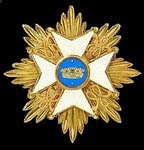Having done the flags for Prussian infantry regiments at Prague, Kolin, Rossbach and Leuthen (apart from IR15 on which I am still working), I am now filling in the gaps in my coverage on the way to the ultimate ambition of doing all the Prussian infantry flags of the Seven Years War. The next regiments I do will therefore be IRs 2, 4, 11, 14 and 16. Here are those of IR2:
Chefs: 12th June 1750 to 1769 Major General Hans Wilhelm von Kanitz, later Lieutenant General
First raised in Far Pomerania and the Neumark December 1655.
In the Seven Years War 1757-9 the regiment had the pleasure of fighting the Russians in four major battles and suffering heavy losses. After the Russians moved into East Prussia on 1st August 1757, 73 year old Field Marshal von Lehwaldt moved against them and encountered superior Russian forces in the Norkitten Forest near Gross Jägersdorf. The regiment was part of the first attack, advancing with lowered bayonets and breaking through the Russian first line on the right wing and then, midst the fog and smoke, colliding with the second line of Russians. With no support from artillery or cavalry the attack crumbled in the face of Russian resistance. In the confusion the Sydow Regiment fired on the rear of the front line Prussian battalions which were then driven back by the Russian counter-attack. The regiment lost 16 officers and 489 men in the battle.
A year later on 25th August 1758 IR2 and six grenadier battalions led the initial attack on the Russians west of Zorndorf in the Zabern valley. The left wing under Lieutenant General von Kanitz (the regimental chef) followed with fifteen battalions. There followed two hours of bitter combat. The left wing veered off to the right in the confusion and was attacked by Russian cavalry that threw it back. Prussian cavalry under von Seydlitz attacked the Russians and gave the left wing some much needed breathing space. But when the King began his main attack against the Russian left wing, Russian cavalry struck Kanitz's battered regiments. Frederick had now seen the East Prussian regiments "fail" twice and so, apart from IR2, they fell into disfavour. IR2 lost 20 officers and 844 men in the battle. (Duffy, Army of Frederick the Great, 1st Edition (henceforth Duffy AFG1) shows around 45% casualties for IR2 at Zorndorf.)
On August 25th 1759 Lieutenant General Wedell, under what he saw as explicit orders from Frederick to attack the Russians, threw his army against them at Kay (Paltzig) even though they outnumbered him two to one. The assault against a prepared Russian position on the Paltzig Heights was inevitably a bloody failure. A third of Wedell's force were casualties and IR2 lost 13 officers and 642 men. The King himself then took command against the Russians and three weeks later, on August 12th, attacked the Russians and Austrians in their prepared positions at Kunersdorf, east of Frankfurt an der Oder. After initial success the Prussian infantry ground to a halt in the heat and dust of the Kuh-Grund in front of the Grosser Spitzberg. A final attack by Austrian and Russian cavalry under Loudon routed the struggling Prussians. The regiment lost nine officers and 472 men. (Duffy AFG1 shows around 25+% casualties for IR2 at Kunersdorf.) They had therefore in two years lost a total of 58 officers and 2447 men!
The remainder of IR2, one battalion strong, were captured by the Austrians at the Elbe bridgehead near Meissen on December 4th of that year. Having lost its own recruiting grounds and station, the regiment was sent to the Stutterheim Corps in Pomerania to be recruited with fresh recruits from Mecklenburg.
The grenadiers fought at Torgau on November 3rd 1760, in the third attack of von Hülsen. On August 1th 1762 the regiment fought in the victory of Reichenbach under von Bevern and then took part in the successful siege of Schweidnitz, which capitulated on October 10th.
Christopher Duffy, Army of Frederick the Great, 1st Edition says of IR2: "Unusually hard-fighting (especially for an East Prussian regiment) with consistently high casualties. One battalion captured at Meissen 4th December 1759." In favour with Frederick after the Seven Years War.
And this was the uniform in 1756:



















